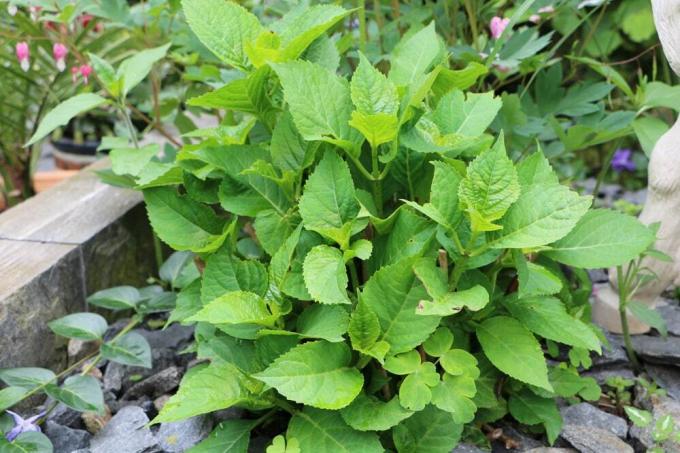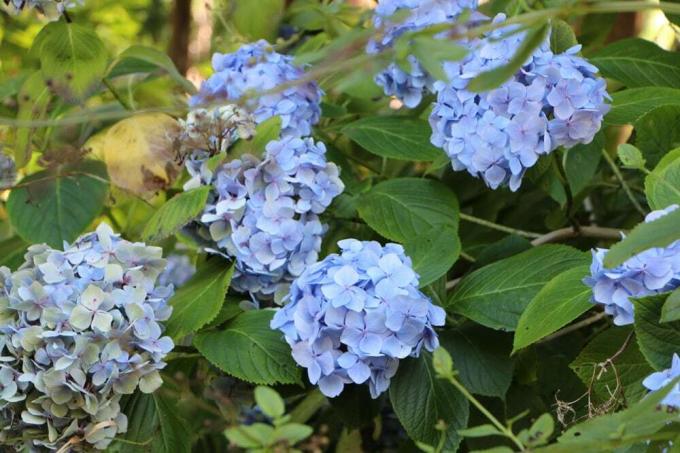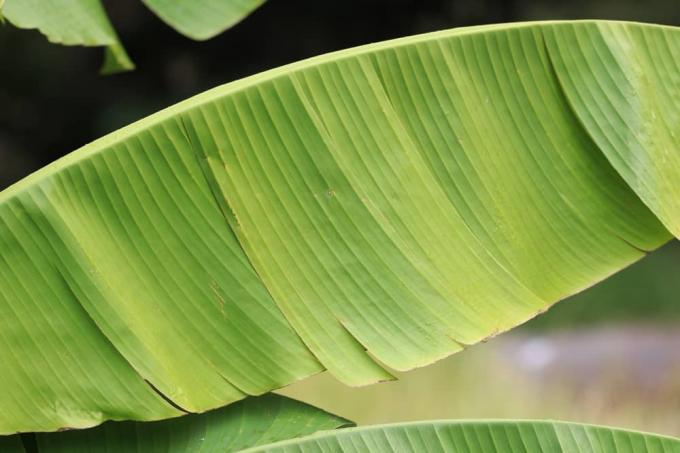

Table of contents
- Location
- substrate
- Pour
- Fertilize
- planting
- Bucket attitude:
- outdoor culture:
- Planting distance for hedge planting
- Cut
- hibernate
- Hibernation outdoors:
- Overwintering in buckets:
- multiply
- Rooting in the cultivation vessel:
- Rooting in the water glass:
- Propagation via sinkers:
- sorts
- plant neighbors
- diseases and pests
- spider mites:
- Mealybug
- aphids
- Conclusion
The Endless Summer® hydrangea is an exceptional breed by the American researcher Professor Michael Dirr. Its name "Endless Summer" keeps what it promises, because it shows its distinctive blooms on new and old shoots from May to October. The withered flowers are simply cut off periodically. It is perennial and frost hardy, which pleases many gardeners and hobby gardeners in Germany. Thanks to its uncomplicated care, the pretty and long-flowering bog plant, which grows between 100 and 120 centimeters high, is ideal for beginners.
Location
If possible, the plant should be in a light to semi-shady location so that it can unfold its lush flowers. Even if the new hydrangea tolerates the sun well, it feels most comfortable in the semi-shade under tall trees, as it is protected from the scorching midday sun. If a location is chosen that is too dark, its growth will be stunted and flowers will rarely, if ever, form. If the wrong location is chosen, it can easily be relocated in the spring after a few years without suffering any damage. Due to its fine root system, it grows back very well.
substrate
The beautiful farmer's hydrangea has shallow roots and is therefore dependent on humus-rich, nutrient-rich soil. Contributing to vigor is well-drained, fresh, moist soil, which is ideally acidic for blue buds - with a pH between 5 and 6. Alkaline substrate is required for the pink flower color. The pH of the soil can be easily checked with a test kit from the garden center.
Tip:
Make sure that the soil is not too calcareous, because the Hydrangea macrophylla, like the Peasant hydrangea is botanically called reacts sensitively to larger amounts of lime, even if their Limescale tolerance is high. Therefore, upgrade insufficient substrate with larger amounts of rhododendron soil or good potting soil.
Pour
The flowering plant needs to be watered daily in spring and summer, depending on the weather, also in the evening and in the morning. Therefore, do not delay watering for too long in dry summers. In the event of prolonged drought and in locations with direct sunlight, you must ensure that you give plenty of water. However, do not water when the sun is shining and do not water on the leaves.
Always allow the top layer of soil to dry between waterings before you top up with mostly soft, lime-free water. The water should preferably be rainwater. Nutrient-rich pond water from your own garden pond is also suitable. Let it flow over the spout onto the roots of the hydrangea. If you keep farmer's hydrangeas in a bucket, be sure to avoid waterlogging.
Fertilize

Endless Summer® is fertilized from March to September, especially after pruning. Rhododendron fertilizer, for example, has proven itself for this. Alternatively, you can also use hummus or horn shavings. The plants tolerate large amounts of nitrogen, but little phosphorus. Therefore, always pay attention to the composition of the fertilizer if you use complete fertilizer.
The best way to cover the high nutrient requirements is as follows:
- Fertilize organically every 2 weeks with horn shavings, coffee grounds, guano or acidic compost
- alternatively administer rhododendron fertilizer with NPK content 7-3-6
- or fertilize in March and June with a special long-term hydrangea fertilizer
planting
The pretty hydrangea breed can be cultivated both outdoors and in tubs.
Bucket attitude:
The Hydrangea macrophylla needs a sufficiently large container with a diameter of at least 30 to 40 centimeters to keep it in the bucket. Thus, the plants are protected from frostbite in severe winters. In addition, the fine roots can spread well in larger vessels and supply the plant with nutrients better. Durable vessels, for example, are made of clay. They also have a beautiful, natural look.
To prevent waterlogging, which is harmful to the roots, put a permeable layer of lava grit, potsherds or fine gravel in the lower area of the container. Cover the drainage hole with a larger shard of pottery so that no grit can trickle through. But leave enough space for the excess water to drain well. Place a jute fleece over the drainage layer to prevent the plant substrate from mixing with the drainage material. The substrate is now placed on the fleece. After planting the hydrangea, gently press the soil and then water generously.
outdoor culture:
The best time for planting outdoors is early spring. The planting hole should be twice as high and wide as the root ball of the plant. This ensures that it roots faster and forms new roots.
Put the hydrangea in the planting hole and fill it up with substrate. Press the substrate lightly and water generously. After that you have to water regularly for the next 2 weeks so that the plant grows well.
Tip:
If you do not know the exact composition of the soil, feel free to use rhododendron soil or soil for ericaceous plants. In any case, you are correct.
Planting distance for hedge planting
The Endless Summer® hydrangea not only looks pretty as a solitary plant, but also as a hedge or in a group of plants. The correct planting distance corresponds to half the growth width. Therefore, always pay attention to the information on the label when buying or ask in the garden store, as the different varieties of this pretty breed have different growth widths.
Cut

Since the flowers of this hydrangea form equally on both older and young shoots, it does not require a radical pruning in late autumn or spring. In this it differs from other representatives of the hydrangea. Even without pruning, Endless Summer® will sprout again in the following year to be bushy and floriferous.
Regularly cutting out the old inflorescences will also encourage them to continue flowering. This so-called remounting has the great advantage that the plant blooms diligently until autumn. As soon as you cut off the first flower that has faded, new flowering shoots will form on the cut branches within 6 weeks.
From the 4th However, this farmer's hydrangea should be thinned out a little during the planting year. To do this, completely cut out two thirds of the old shoots. This stimulates the plant to form new shoots and buds.
hibernate
Hibernation outdoors:
All Endless Summer® varieties have a very good winter hardiness and should withstand temperatures down to -30 °C. Nevertheless, late frosts in spring can kill off the blossoms that have developed early. Therefore, cover the hydrangea with jute or linen to protect the flower buds from late frost. If that doesn't help, the plant will still produce new buds a few weeks later.
Overwintering in buckets:
You only need to wrap the plant pot with a special fleece or coconut mat so that the substrate and the root ball of the hydrangea are protected from freezing completely. Otherwise the bucket can remain in its place.
If you want to be on the safe side, you can also overwinter the tub hydrangea indoors:
- preferably in a large, bright conservatory
- lots of water and enough light
- Avoid waterlogging
- allow the substrate to dry out a little between waterings
Tip:
Even if the hydrangea seems completely frozen, simply cut the frozen brown shoots liberally back to the next healthy eye, and in the same summer it will bloom on the new shoots start. The plant will still flower even if you cut off all the shoots at ground level.
multiply
The Hydrangea Endless Summer® can easily be propagated by cuttings. It is best to take cuttings in early summer. This allows the young plants to form enough roots before the frost sets in.
To make the cuttings you will need the following materials and tools:
- Cultivation vessels, such as simple yoghurt pots or flower pots
- a sharp knife
- transparent foil or small mason jars
- a glass of water
- Cultivation substrate or nutrient-poor plant substrate, such as 2/3 sand and 1/3 garden soil
- possibly rooting powder to accelerate rooting
To obtain cuttings, in June or July separate young shoots about 1 cm long. 12 to 15 cm from the plant. The shoots must not have flowers or flower buds. Cut off the front piece from the upper pair of leaves of the cuttings and defoliate half of the shoot from the lower end. This is necessary to stimulate root formation. In addition, fewer nutrients are required.
Rooting in the cultivation vessel:

If you want to speed up the rooting of the cuttings, dip the cut surface of the shoots in rooting powder. The powder has important minerals that promote rapid sprouting of the fine roots.
It is best to fill the planters before preparing the cuttings so that they are not separated from nutrients and water for too long. Put them individually in pots with growing substrate or several in boxes. Pin the cuttings very tightly.
The best way to do this is to drill holes in the substrate with a small wooden stick and insert the cuttings with the cutting edge first. Then press the soil lightly and water the cuttings well.
Finally, cover the vessels with transparent film so that the young hydrangeas root faster. Alternatively, mason jars are also possible. However, do not forget to ventilate so that gray mold does not form. The vessels should be in the bright shade and not in the blazing sun so that the soil does not dry out too quickly and the young shoots do not burn.
As soon as after approx. Once roots have formed after 3 to 5 weeks, the young plants can be repotted into larger containers. They are not allowed outside until next spring.
Rooting in the water glass:
– Fill the glass with water
– Cover the water glass with transparent foil
– Poke holes in the foil
– Stick the cuttings through the holes so that the stems are at least 3 to 4 centimeters in the water
After a few days, roots form at the interface. As soon as sufficient roots have formed, you can plant the cuttings in containers.
Propagation via sinkers:
Endless Summer® can also be propagated very well using sinkers. Choose healthy shoots without flowers or buds. Remove the foliage except for two leaves at the tip of the shoot. Then bend the shoot down to the ground and cut the spot for rooting diagonally with the knife. Now place this part of the shoot in a small hollow and fix it. Cover them with soil without covering the shoot tip. after approx. Roots develop after 1 year. The young plant must remain on the mother plant for that long and must never be cut off.
sorts
- The Bride - white flowering
- Twist'n Shout - flowers blue to pink (plate hydrangea)
- Bella Anna – pink flowering
- Blushing Bride - white to pale pink flowers
plant neighbors
Combine the hydrangea with other plants, such as shade grasses, hostas, rodgersias, shade bells, Japanese maples or bamboo. It does not necessarily have to be set as a solitary plant. The different varieties look just as beautiful next to each other and offer a wonderful bloom. However, the accompanying plants should not be too tall, lest they suppress the growth of the hydrangea.
diseases and pests
The hydrangea Endless Summer®, like other hydrangea species, can be attacked by various pests.
spider mites:
These tiny animals are only about half a millimeter in size. That is why they can hardly be seen with the naked eye. They often occur in dry summers or overly dry winter quarters. A silvery shimmering leaf surface, which is caused by air in the empty cells, is their distinguishing feature. As soon as you notice such leaves, you know that spider mites are at work. Small webs can also be seen, which you can make clearly visible with a fine spray of water. The underside of the leaf often has irregular, brownish discolorations. If nothing is done against the spider mites, the shoots will turn black and the leaves and young branches will die.

You can use predatory mites or lacewings to combat spider mites. If you keep hydrangeas in pots, it is advisable that you expose them to high humidity for a short time. To do this, water the plant properly and then put foil over the leaves so that the plant is completely covered. If that doesn't help, try soft soapy water.
Mealybug
Mealybugs, also known as mealybugs, are the most difficult to control. They can be recognized by a fine white web that surrounds them. The animals are approx. 5 millimeters in size and can be found on all parts of the hydrangea. As they feed on the sap of the plant, they secrete a toxin with their saliva that stunts the plant's growth. As a result, the affected leaves turn yellow and eventually fall off.
The harmful insect can be combated biologically with natural enemies of mealybugs, such as lacewings, ladybirds and parasitic wasps. The beneficial insects, which can be used both outdoors and in the conservatory, can be purchased from specialist retailers.
aphids
Aphids are insects that belong to the so-called weak parasites. Of them there are approx. 800 different species. They prefer to suckle on weak and young shoots. They are only a few millimeters in size, but can be seen with the naked eye. In addition, stunted leaves, falling buds and poor growth indicate an infestation.
The sucking insects can be driven away with a bold jet of water. However, if that doesn't help, spraying with ecologically compatible treatment products from specialist stores makes sense. Regular spraying with nettle or field horsetail broth can also prevent infestation with aphids.
Conclusion
The Hydrangea Endless Summer® is an uncomplicated, repeat-blooming hydrangea variety that will delight you with its beautiful flowers all summer long into autumn. Since it is extremely frost-resistant, it can stay in the garden in winter. The last blossoms in autumn offer a refreshing eye-catcher. Thanks to its robust nature and its undemanding care, it is perfect for beginners.
 garden editorial
garden editorial I write about everything that interests me in my garden.
Learn more about potted plants

Abalie, Abelia grandiflora: 14 tips for proper care
The large-flowered abalia (Abelia grandiflora) is an extraordinarily easy-care ornamental shrub that delights with numerous funnel-shaped and subtly scented flowers. It is just as suitable as a background plant as a hedge or container plant.

Caring for the tangerine tree properly | 13 tips for the tangerine tree
Many citrus plants have evolved from the tangerine, one of the oldest and most original citrus species. With its white flowers and orange fruits, it is a feast for the eyes and the palate. In this country it is only cultivated as a container plant due to its sensitivity to frost.

Indian canna, Canna indica | 13 tips for care
Canna indica, also known by the botanical name Canna indica, is a decorative plant that not only enriches every garden during flowering. In pot culture, it can be used as an accent for many years thanks to its color and growth.

11 absolutely hardy container plants
Absolutely hardy potted plants have several advantages to offer, because they can remain outdoors even when the temperature is below zero and require little protection. If they are also evergreen, they can also bring joy all year round.

Is dwarf bamboo hardy? | 11 tips for care & cutting
Dwarf bamboo is one of the easy-care sweet grasses. In the garden, it can be used as a good ground cover, as it does not grow as tall as its larger relatives. Whether the plant is hardy and how it is cared for and cut can be read in the guide.

Pink dwarf banana, Musa velutina | Care of the Kenya Banana
The pink dwarf banana (Musa velutina) is an eye-catcher in the garden. It grows to a maximum of two meters and impresses with its impressive flowers. The small pink fruits taste sweet and aromatic. If you want to harvest the exotic fruits, you should follow our care tips.
